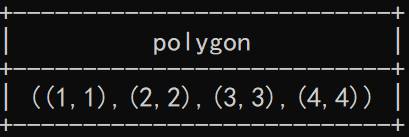PostgreSQL mainly supports some two-dimensional geometric data types, such as point, line, lseg rectangle, path, polygon, circle, etc.
This article will introduce the input of geometry type in detail. Note: each type has several equivalent input forms.
1. point
select '1,1'::point; select '(1,1)'::point;

2. line
select '1,1,2,2'::line; select '(1,1),(2,2)'::line; select '((1,1),(2,2))'::line; select '[(1,1),(2,2)]'::line; select line'1,1,2,2'; select line'(1,1),(2,2)'; select line'((1,1),(2,2))'; select line'[(1,1),(2,2)]';

3. Line segment (lseg)
select '1,1,2,2'::lseg; select '(1,1),(2,2)'::lseg; select '((1,1),(2,2))'::lseg; select '[(1,1),(2,2)]'::lseg; select lseg'1,1,2,2'; select lseg'(1,1),(2,2)'; select lseg'((1,1),(2,2))'; select lseg'[(1,1),(2,2)]';

4. Rectangle (box)
Bracket [] cannot be used for rectangle type.
select '1,1,2,2'::box; select '(1,1),(2,2)'::box; select '((1,1),(2,2))'::box; select box'1,1,2,2'; select box'(1,1),(2,2)'; select box'((1,1),(2,2))';

5. path
In a path, square brackets [] are used to indicate an open path, while parentheses () are used to indicate a closed path. Closed path means that the last point is connected with the first point.
select '1,1,2,2,3,3,4,4'::path; select '(1,1),(2,2),(3,3),(4,4)'::path; select '((1,1),(2,2),(3,3),(4,4))'::path; select path'1,1,2,2,3,3,4,4'; select path'(1,1),(2,2),(3,3),(4,4)'; select path'((1,1),(2,2),(3,3),(4,4))';

select '[(1,1),(2,2),(3,3),(4,4)]'::path; select path'[(1,1),(2,2),(3,3),(4,4)]';

6. polygon
Bracket [] cannot be used for polygon type.
select '1,1,2,2,3,3,4,4'::polygon; select '(1,1),(2,2),(3,3),(4,4)'::polygon; select '((1,1),(2,2),(3,3),(4,4))'::polygon; select polygon'1,1,2,2,3,3,4,4'; select polygon'(1,1),(2,2),(3,3),(4,4)'; select polygon'((1,1),(2,2),(3,3),(4,4))';

7. circle
select '1,1,5'::circle; select '((1,1),5)'::circle; select '<(1,1),5>'::circle; select circle'1,1,5'; select circle'((1,1),5)'; select circle'<(1,1),5>';
